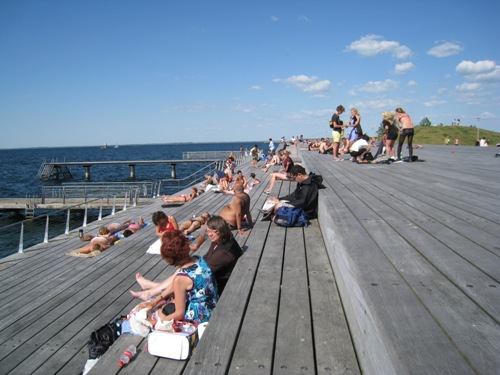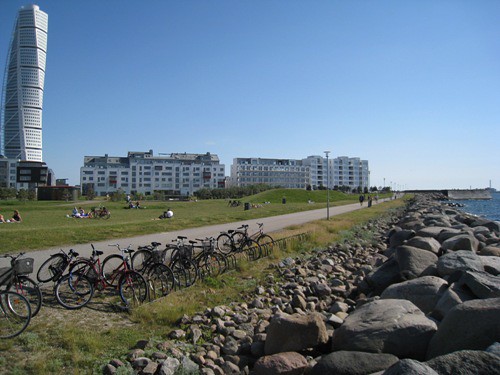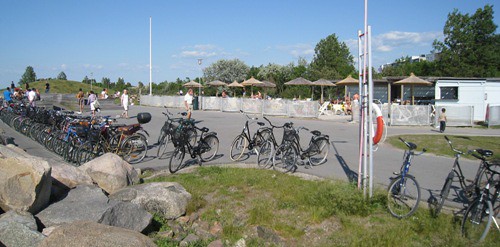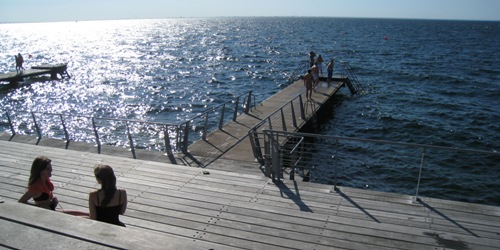
MALMO – On a recent trip to Denmark, I crossed the bridge from Copenhagen and spent a few hours in Malmo, Sweden. This small city of 270,000 is impressive in its creation of lively public spaces, likely taking cues from its Danish neighbour across the Baltic Sea. Beyond its attractive city centre park, countless public squares and pedestrian streets, the city’s formerly industrial waterfront is alive with activity.

The waterfront is a mix of mid-rise apartments, commercial and office space, parkland, recreational trails, and ample boardwalk and docks for sunbathing and even taking a dip in the sea. The one iconic landmark is the modern Turning Torso, which resembles the Marilyn building envisaged for Mississauga. Note that it’s just one 57-storey skyscraper on the Malmo waterfront, as opposed to a wall of condo towers on another unnamed waterfront.

What is so impressive about this area is how appealing it has become to Malmo’s residents. Despite the fact that it’s not all that accessible or connected to the rest of the city – it’s about a half-hour walk from the edge of the city centre – it’s still full of people throughout the day. Right by one of the massive wooden steps and docks for swimming is a beach bar with umbrellas that resemble those at HTO Park in Toronto. In contrast, there is typically no sale of alcohol on Toronto’s public spaces, nor is consumption in public spaces allowed – though that’s a whole other debate (could North Americans handle public drinking?).
There is currently a wealth of planning, design and construction for Toronto’s waterfront. As we take a look at plans, attend public meetings and await decisions, we can hope that what we end up with will entice and excite us. For now, Toronto’s done with Swedish superstar hockey player imports, so how about some Swedish waterfront planning and design?





16 comments
Reading about how poor our city manages the space we have available makes me want to move somewhere else.
our condo wall wouldn’t be quite so bad if 80+% of the buildings weren’t really ugly… 🙁
There is nothing wrong with our condo “wall” per se – lots of waterfront buildings have a solid urban edge of buildings, many with worse architecture. It’s all about the train tracks, the Gardiner and the thin public strip at the water’s edge. Toronto has made some good strides with HtO, Music Park, etc. but it’s great to see these essays reminding us that the world is not static and other cities are improving at an even faster pace. A continuous pedestrian pathway, spots of interest, seating and the occasional open space can do wonders.
Sorry, I meant to say “lots of waterfront cities have a solid urban edge of buildings”. Buildings on the brain…
We had a huge lead on American cities, then in decline, in the 80s. Now NY and Chicago repeatedly show us up, never mind European cities. I hope people remember what happens when you vote for a ‘common sense revolution’ when you live in a city which is the creature of the province.
Actually, it doesn’t matter who we vote for in the 416 then, does it?
If the “wall of condos†had been just a “knee wallâ€Â, then our own waterfront would have been 10 times better. I don’t mind condos along the waterfront, but it’s their massive height, boxy footprint, & design ugliness that detract the harbourfront.
It would have been better if they were setback, terraced, & had a restricted height of only 10 floors. (more like ones along Queens Quay on the west side of Spadina). Instead the Westin Harbour Castle hotel & the tall condos immediately next door to them set an awful precedence.
What I find interesting is how similar our existing Harbourfront promenade is to the “ideal” promenade presented above. See, for example: http://biketoronto.ca/images/content/467/HarbourfrontPromenade.jpg
Due to the incrementalism of Waterfront Toronto’s changes over the years, I’m not sure Torontonians have been able to appreciate quite how nice portions of the waterfront now look and how busy and successful these sections are. I’m hopeful that perceptions will change once the Central Waterfront West8 DTAH Queens Quay revitalization is finally complete.
Spacing: Drooling over the Scandinavian Urban Landscape.
Judging from the photoes, I found the Malmo beach is not at all comparable to our waterfront. Theirs is almost in a suburban setting, with much lower density than Queens Quay area. If you have to compare, it probably make more sense to compare it with the Beach area. I do agree with John the condos between Spadina and Bathurst work much better the those highrise towers to the east, but still, I have high hope for the new revitalization plan at the waterfront. Should it be complete as planned, ours isn’t gonna be shabby at all.
To be honest, I am not overly keen on the broad plains of open parkland along the waterfront concept. Some of those images are reminding me more of the Mississauga parks created on fill in Lake Ontario in the 70s or 80s. Compare this to the boardwalk and park space east of Woodbine, where there is variation in the width of park space and in whether it is open or treed — I find it makes for a much more interesting and vibrant environment (and is more likely to be used even in winter because it does not seem so open and windswept).
There’s also quite a similarity between some of the pictures and the new waterfront parks around Port Union in Scarborough. Also, if you want a quieter shoreline, there’s Humber Bay Park in Etobicoke, and a very residential stretch through New Toronto.
It seems to me that much care should be taken in comparing a waterfront 30 minutes’ walk from the downtown core of a city of 270,000 and one that’s 15 minutes’ walk from the downtown core of a city ten times the size. It’s not such a huge surprise that our waterfront is more urban. That’s both a challenge and an opportunity: that so many people now live along the waterfront means the city can no longer be accused of turning its back on the lake, as it was for many years.
A dear friend of mine is Swedish, and has lived outside Malmo her entire life.
She tells me that this new waterfront, at least what has been built, was aimed at the very wealthy. She also told me that the boardwalk wood used was obtained from rainforests, and that the rocks that line the edge were polished in China.
The grass isn’t always greener on the other side.
The biggest problem I have with the current built form on our lake front is not the height so much but the type. Because so much of it is condos I feel like I am an unwanted guest.
That is why I prefer buildings that form a wall by a public space be more public in nature, not private dwellings.
It may be that Malmo has a great waterfront, but I have to admit that these photos don’t especially make me want to visit it. Looks like a nice day, but there’s an awful lot of just grass and not that many people.
I agree with comments that the two are not really comparable, given the size of the city’s and relative location of the waterfronts within the city.
I find most waterfront comparisons disparage Toronto’s, no matter the criteria. If you compare a city like Vancouver where recent development has seen tall condos close to the water’s edge, then Toronto comes up lacking in terms of the pedestrian experience along the water. If we are compared with Malmo, we don’t have enough big grassy fields there. I often feel that we can’t win, yet I’ve been on many waterfronts in various places in the world that left me feeling less than enthused.
Am I wrong to actually like the considerable variance in Toronto’s waterfront, from the grassy paths that have been quite nicely constructed recently on the western waterfront, to the more urban Harbourfront feeling, to the still-abandoned feeling portlands and Cherry Beach? And there is no mention in this article of the many small and fabulous upgrades at Harbourfront like the edge landscaping, HtO, and the incredible wave decks that are rolling out rapidly.
Have to agree with you there, Bob. I often wonder if Torontonians should (and I am stealing shamelessly from JK Rowling here) start to learn to appreciate the waterfront they’ve got, rather than fret about the one they think they ought to have.
The Malmo pictures don’t do a thing for me, and besides, Toronto isn’t Malmo, and for that matter, it isn’t Chicago or New York, either. It has its own unique aspects, and urban change in Toronto is usually incremental, rather than all at once.